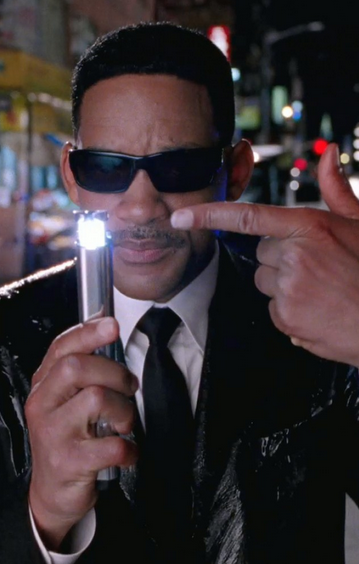Basically all atomic models that would lead you to that conclusion are wrong.
Models in general are wrong.
But some are useful
Including the one where the solar system is one big atom.
I don’t think you understand their point. They’re saying that what if we exist at the scale of storms to us as some incomprehensibly larger beings’ universe.
If the solar system was an atom, our motion would be governed by quantum mechanics, not newtonian mechanics. Which is not the case.
Look this is every stoner freshman dorm thought since 1965 probably
While others have correctly pointed out that the model of atom which is reminiscent of a solar system is not accurate. I would like to point out that systems of massive bodies in space could possibly be used in some ways similar to atoms.
The closer you get the stronger the pull is, but if you’re going fast enough, you can find stable configurations. This means it is possible (though incredibly unlikely) that if two solar systems interacted the right way, you could get a stable combined system. Two systems could orbit each other with or without sharing planets which is reminiscent of certain kinds of atomic bonds. You can even have system interactions where one system steals a planetary body from another. Sure there’s no ionic bonding because gravity isn’t polar but it’s still possible to create “bonds” of some kind.
Also, the specific configuration, total mass, and number of massive bodies in each system would affect how it interacts with any other system, kind of like chemical properties of elements.
If you throw a massive enough thing fast enough you can rip a solar system apart kind of like how throwing a neutron or nucleus fast enough at an atom can break it apart.
Complex gravitational systems can have specific and often complex physical structures/shape too, which could be argued as similar to the way proteins have complex and specific shapes. These shapes would change the way the systems interact with other systems because gravity and distance are related. Again creating these stable configurations would be unlikely but still not impossible.
Hell, there are even weirder similarities too. Stars and black holes “decay” and the collision of planets can yield different numbers of “particles” which interact in new ways because their mass is different.
Sure, gravitational systems are not nearly as stable as atoms, they probably couldn’t be ordered into a table like elements, and do not operate on exactly similar forces like atoms. System-chemistry would also be very directional which would be tedious, but I think it’s cool that it could be possible to do similar things with gravitational systems as you can with atoms, even if they don’t have similar structure or internal properties.
Well due to absence of gravitational repulsion, the bonded “atoms” would come closer and collapse right?
Oh yeah eventually they will. But eventually protons will decay. Could you do something with these bonded “atoms” before they collapse? Probably not as much as you can before an atom decays but yeah you’ve definitely got at least a few million years for most systems right?
Unlike proton decay, the “atoms” in your system will accelerate towards each other and will not make any kind of “stable” system as you have mentioned. A chemical bond analogue is not formed but instead a nucler reaction type will occur. But should we call pressing two clay pieces together as some nuclear type process? I don’t think so.
Not to mention electron does not revolve or have ant kind of orbit. Its too different to be called similiar
Firstly, you are wrong. Binary star systems are a good example this. Secondly, thank you for helping me find more similarities between atoms and stellar systems and learn new words.
From the Wikipedia page for Binary Star System:
it is not impossible that some binaries might be created through gravitational capture between two single stars
Again is it unlikely? Hell yeah but I covered that point previously and the important part is that it is still possible.
Next, I need to thank you because you helped me find out that your “nuclear type reactions” happen and are similar to nuclear combination of atoms.
The orbits of planets in a binary system can be circumbinary which would be the “nuclear type” as you called it where the stars (or most massive body in the system) begin orbiting each other and planets orbit around both as though they were a single massive object.
However, they can also be circumstellar (as I described previously) meaning the two stars orbit each other but the planets orbit only one star each. This would be much more analogous to an ionic bond (though again without polarity) where two atoms are attracted to one another but do not share electrons.
Furthermore, it seems there is even more similarity as the circumbinary systems are more unlikely to break apart but the circumstellar type require stars to be far enough away would make them more easily dislodged. This seems similar to nuclear decomposition being much harder to pull off than chemical decomposition.
But wait, there’s more.
Some binary stars orbit each other so closely that they share the same atmosphere, giving the system a peanut shape. While most such contact binary systems are stable, some do become unstable and either eject one partner or eventually merge.
Even if the stars get close enough to touch, they can still be differentiated and are “stable” This seems much more like a nucleus since the “particles” are packed tightly together and the whole “becoming unstable means I eject a particle” kind of screams radioactive decay.
Anyway, there are “periodic solutions” (stable configurations that follow a cycle) to the three body problem and there are likely some for n-bodies. So contrary to your assertion, it is possible to make a stable system with multiple massive bodies that do not combine “nuclear type”.
As you can see from the images on the Wikipedia page, these systems have unique shapes which is what I was referring to as the analog of proteins having specific shapes.
Lastly, the first line of my original comment was that yes, these solar sustems are reminiscent of a wrong model of the atom. I’m well aware of the structure of electron orbitals and Schrödinger’s equations for electron position etc.
My point was not to say that stellar systems are structured just like atoms or behave exactly like them either. My point wasn’t even that there are more similarities that differences. It was simply that there are similarities between the two and that you could build some analogous structures/chemistry with gravitational systems.
Binary star system exist because they are revolving around a common center, and its outwards momentum is holding them in place.
The binary systems are formed from splitting of one star or in the formation of the star itself. In your atom model, chemical bonds like bringing together two atoms and they form stable bonds is not possible. If you say this gravitational atom model have more close relation with real atom model than differences, then I could also say two magnets in space which spins around each other due to magnetic force and the centrifugal force(which came from inertia at initial conditions) balancing is also analogous to an atom. You have to perfectly set the velocites and magnetic moments but you will get something like a binary system. I would conclude there are bigher differences than simple structural similiarities to a (wrong) model of atom
Gravitational capture occurs when one object enters a stable orbit around another (typically referring to natural orbits rather than orbit insertion of a spacecraft with an orbital maneuvers).
So saying it “is not possible” is verifiably wrong. The perceived rarity of gravitational capture is most likely just due to how empty space is, not the unlikelihood of stability.
On that note, I think you might want to do some math yourself. You seem to be laboring under the impression that there are limited or maybe only a single exact state of stability for systems like this. “You have to perfectly set the velocities and magnetic moments” I’m not sure about magnets but I am sure about gravitation, and you don’t need to be very precise at all.
If you know how to code I’d suggest you try simulating two bodies with random masses traveling at random velocities. You’ll see that many times they do swing apart and a few times they will directly collide but there is a wide range of stable orbits. Sure, if you wanted to get perfectly circular orbits, you’d need to be more precise, but circular orbits are not necessary at all. Most orbits are at least a little eccentric, and eccentric orbits are still stable orbits. Importantly, they can be created without precision.
Next, while binary systems are assumed to form during star formation as you assert, the quote I listed from Wikipedia says it is possible for binary systems to form via gravitational capture.
Anyway, since that wasn’t enough evidence for you I decided to find an example of a combination system. Fortunately I didn’t have to look very far.
Alpha Centauri (our nearest stellar neighbor and triple star system) is a specific example of stable combination. Rigil and Toliman are main sequence stars that likely formed the way you listed since they are very close together and roughly the same size with slightly more massive than the other.
However, Proxima Centauri is a red dwarf that orbits the two circumbinarily. It is .2 light years from the other two which means it is roughly 5% of the distance to us from the barycenter of Toliman and Rigil.
However, despite the distance, it is “gravitationally bound” to them and its orbit has a 30deg inclination relative to them. This out of plane motion, the large distance, and the eccentricity of its orbit, imply that Proxima Centauri did not form from in the ways you listed. It may have formed in the same nebula as the other two, but it also very possibly could have travelled before getting gravitationally captured. In either case, it was gravitationally captured by some means and has formed a stable system despite having an out of plane velocity.
Proxima Centauri even has circumstellar planets, and its small mass and large distance from the binary pair mean it very easily could be stolen from the system if another main sequence star passed closely by. So it’s a great example of this “bonding” I’ve described.
Now magnets. Your magnet analogy is not similar to these scenarios because electromagnetism is highly directional. I don’t think you’d be able to combine systems of spinning magnets in any stable configuration other than a straight (spinning) line of them. However—as shown by the Alpha Centauri system—it is very possible to form stable multistellar systems from the combination of two stable systems.
Lastly you are correct that there are many many differences between atoms and gravitational systems. I mean shit, we don’t even know how atoms really work. String theory and particle physics don’t play nice and there are many more theories for unifying relativity and quantum physics that would impact what the “true” internal structure of an atom is like.
However, as mentioned in my last comment, that is not the point! My point was simply that there are some similarities and that you could do certain things with them that would have chemistry analogues. Does that make sense? I’m not saying “these are the same” I’m saying “it might be possible to use these in some similar ways to atoms.” And I’ve now found proof it is possible because of this debate, but the point of my original comment was curiosity/discovery not debate.
I wasnt saying it was not possible for gravitational captured system, but bringing your two atoms together and they bond is not possible(because it keeps falling into each other). It’s the (outward)momentum that keeps such a system stable. It would not have form a stable system when you keep it near without any velocity to spin around each other, it will not form a stable system–another dissimiliarity from atoms.
Its hard to make a stable system with magnets so i said perfectly setting velocities. As you mentioned, a straight line spinning was what I imagined when writing. But i’m asking if you set it and made it work, would you count that also as some kind of atomic model?
If you are just saying there are some similiarities with atoms, sure! But then many things has some similiarity to atomic model. Your examples sure could be regarded as such atomic bonds philosophically. I couldn’t imagine stealing proxima centauri as bonding, since its already so far away from “nucleus”. Or in your analogy it could be atom held by van der Walls force being removed… man… I gave you another point
And I don’t know If there would be a magnetic bonding scenario but I think it might be possible with complicated calculations and perfect initial conditions. Also what about some ferromagnetic metal moving around a magnet?
What I am trying to point out is that any-force system could be then regarded like capable of being like an atomic model with chemical-like properties.
It’s the Men In Black marble scene again.
No, it’s the AT scene in which Finn sees Princess Bubblegum’s given cosmic awareness.
MIB just ripped them off.
Umm… MIB (1997), Adventure Time (2010).
Or is this a “that’s the joke” moment?How can they rif off MIB when we are not allowed to remember it?
I agree.

This is the real joke.
Wait, what joke?
Woooooah, it’s not though
Even if it was, who gives a fuck, I’m trying to sleep
And not even by a long shot!
What they found down there… defies explanation.
A reality that has blurriness encoded into its’ fabric.
“What if our entire Solar System is just a plum pudding?”
JJ Thompsonand proxima Centauri and it’s planets are another atom
and its* planets are
deleted by creator
This thought has l kept me awake fire longer than I care to admit
An excretion(accretion) disc points to a different phenomenon causing the orbits. As opposed to a shell representing probability and energy level. But they are similar.
All this to really point out that I too have stayed awake thinking about this for a long time
The electron shells are just a model, that’s not how it really works. Look at this image for a more realistic model of how an atom works:
https://en.wikipedia.org/wiki/Atomic_orbital#/media/File:Hydrogen_Density_Plots.png
Accretion disc. Your word scans like a real word but seems less than palatable
The atom model we’re talking about is really, really unlike an atom
You know it just never seems weird at the time. The words are all kinda jumbled up. Never did well in spelling
Yeah. I’m good at spelling, but I still read over my errors and don’t see them until after pressing send
I edit so many of my own comments right after tapping submit, I have set up a five minute delay on outgoing email for the same purpose






